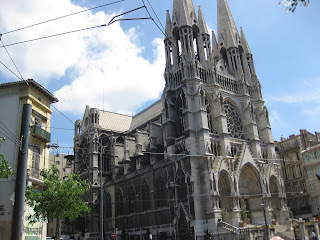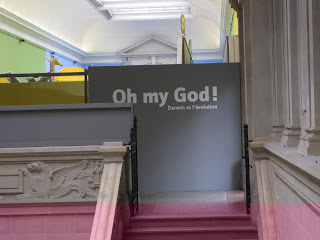5/14/10
"On the bus between Avignon and Nimes,
three days into the organ trip of southern France. This trip has been interesting on several
levels: the locales visited, the organ music, the travelers (26 individualistic
– I could even say eccentric – organ aficionados, although only about half of
them actually play the organ), the history (papal schisms, the Albigensian
“heresy”), and of course, the opportunity to learn things I know very little
about.”
The above was the only paragraph I
managed to write in my journal during the entire Pipedreams organ tour in
southern France. We were up and out early every morning, going all day
long, and then bussed back exhausted and overwhelmed by our experiences. I
usually just collapsed in the hotel bed. I was glad to have had a single room,
with no roommate to chat with or keep me awake.
We had spent two nights in Avignon, and
the better part of two days visiting churches in the vicinity and listening to
their organs, most of which were newly built. The tour through the Popes’
Palace was an enlightening foray into history and religion.
 |
| Temple Saint-Martial in Avignon,ancient ruins outside |
On the morning of Friday, May 14, we visited
another church in Avignon, the Temple Saint-Martial. This is a protestant
church, but was originally the church of a Benedictine monastery. Again, the
organ is a new one, built by our contemporary organ builder, Pascal Quoirin. In
this case, the cabinetry for the metal pipes is quite modern in design, unlike
that in the Collegiale Saint-Martin in Saint-Remy. The organ had an enormous,
full tone with the stops out. Also, it had a hand bellows, not used for most of
the music, although we heard one piece with hand-pumped air, and the
sound was large and full. In general, the lower tones were very mellow,
although in the higher registers the pipes seemed somewhat shrill. All in all,
the sound was as good as, or better than, most of the older organs we have heard.
 |
| Modern organ inside Temple Saint-Martial http://www.youtube.com/watch?v=PBbckUE2Tyg |
From Provence,
we crossed into the province of Languedoc, the center of the Albigensian heresy
that convulsed southern France for a more than a century. It seems that the
Crusade against this “heresy” by the Catholic Church in the 13th
century, and its efforts to stamp out heresy thereafter, ultimately gave rise
to the Inquisition that swung into full force during the Protestant Reformation.
 |
| Cathedrale Saint-Theodorit |
The second
church we visited on Friday was the Cathedrale Saint-Theodorit at Uzès. The
church is a very old one, begun in the 11th century, and mostly destroyed in the 17th century, all except for the bell tower. The bell tower
reminds me of the towers of early Christian churches on the east coast of Italy
– in Ravenna. The organ is also an old one, constructed originally in the late
17th century, probably when the church was rebuilt. The organ has
been restored twice, in the 19th and 20th centuries, with
the aim of recapturing its original sound and elegance. The organ has a good
tone, and its gilded casing is the most elaborate I've seen so far on the tour.
Again, I've linked recordings of the organs made by Ian Cook and uploaded to YouTube, as well as a recording of the Saint Theodorit organ by Finoskov Productions that illustrates both its magnificant tone and the exquisite baroque cabinetry.
Again, I've linked recordings of the organs made by Ian Cook and uploaded to YouTube, as well as a recording of the Saint Theodorit organ by Finoskov Productions that illustrates both its magnificant tone and the exquisite baroque cabinetry.
 |
| Elaborate17th-century gilded organ
cabinetry http://www.youtube.com/watch?v=scDtNldaenU http://www.youtube.com/watch?NR=1&v=pVOaDmj9RiE&feature=endscreen |















































